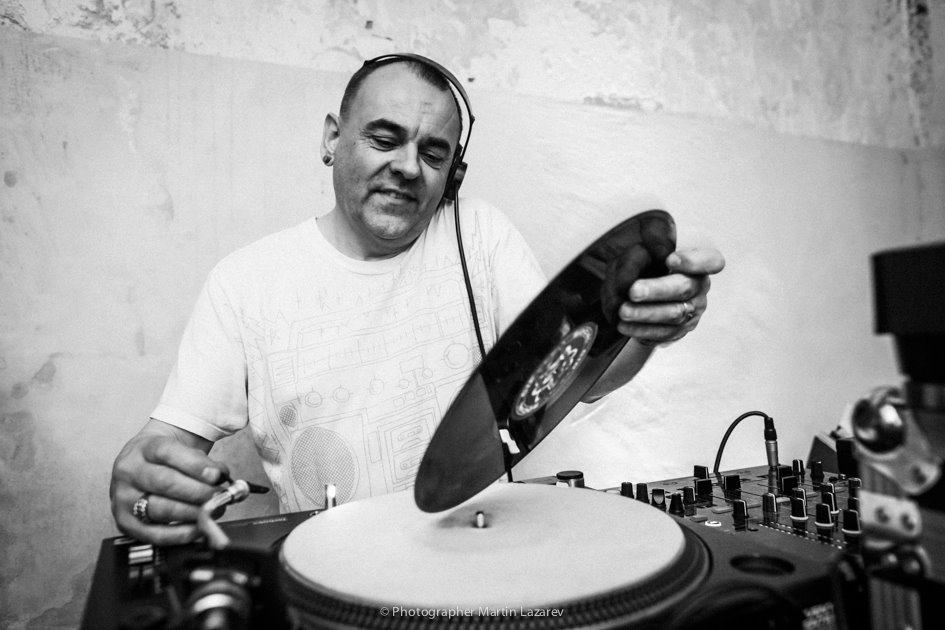
Birmingham and the West Midlands is so often emitted from documentaries, and national news features, when it comes to music scenes or people of influence. Perhaps this is down to the fact that true Brummies are usually disinterested in shouting about their accolades, or self obsessed back-slapping, and seem more content to ‘just get on with life’.
In that respect, documentation of the city’s musical heritage is sparse on the ground, with a few exceptions such as Jez Collins’ ‘Birmingham Music Archive‘ and the ‘Brum Beat‘ archives.
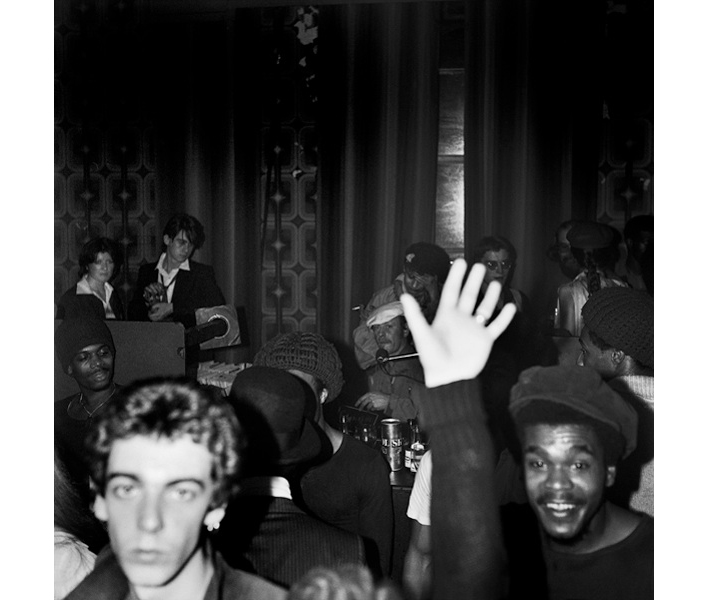 The city council have little money, interest, or resources, to have any permanent home for the city’s music heritage. Present day music venues often get little help, and suffer the nuisance of noise complaints of new neighbours, or having to deal with contentious planning applications which could damage future licensing. This is a huge shame, because for those in the know, Brum’s music background is an extremely rich tapestry which needs preserving and nurturing – and there is great value in doing so.
The city council have little money, interest, or resources, to have any permanent home for the city’s music heritage. Present day music venues often get little help, and suffer the nuisance of noise complaints of new neighbours, or having to deal with contentious planning applications which could damage future licensing. This is a huge shame, because for those in the know, Brum’s music background is an extremely rich tapestry which needs preserving and nurturing – and there is great value in doing so.
The city’s music history is a fascinating and influential mosaic of different cultures, from reggae to heavy metal, psychedelia to house, hip hop to punk, new romance to experimental electronica, bhangra, classical.. it’s all there, and much of it deep underground, undocumented.
In this Q&A we catch up with Chris Rhythm Doctor who started out DJing in the late 70s and has since been involved in the West Midlands music scene, taking his knowledge and skills to far flung places.
One of the seminal club nights Chris picks out, is the once legendary Shoop Shoop (see image courtesy of Bernard Mills), which took place at the now demolished Golden Eagle on Hill Street. The Eagle was a stage to the likes of blues legend ‘Sonny Boy Williamson’, with regulars such as Robert Plant and Steve Winwood in the 60s. Watch this space for a forthcoming article on Shoop Shoop with some enlightening images from the cultural melting pot that was 1970s Birmingham.
Chris Rhythm Doctor Interview + Mix
Hello Chris, I hope you are well and thank you for taking time out to answer these few questions for Grapevine Brum.
No problem, all good thanks Nick.
I first became aware of your work via Bill Brewster & Frank Broughton’s DJ History forum, and later Facebook. I have since learned that you have been DJing in and around the West Midlands since the 1980s. What sparked up your passion for playing records and when/where was your first ever gig?
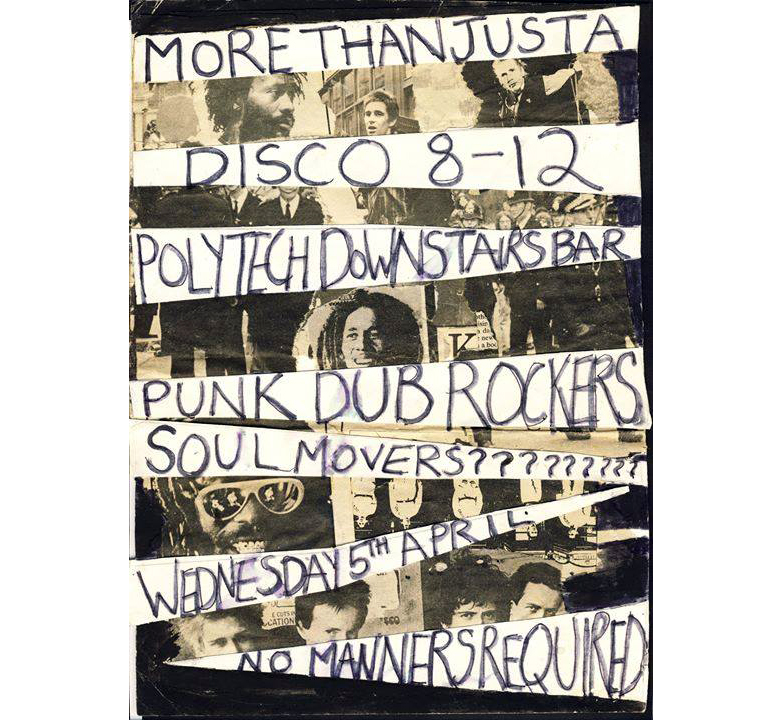 “My first gig was on Wednesday 5th April 1978 at what was then the Lanchester Polytechnic in Coventry. I only know that cause I still have the flyer. I went there to study Fine Art. More than 10 years previous I was a ‘selector’ at the youth club disco.
“My first gig was on Wednesday 5th April 1978 at what was then the Lanchester Polytechnic in Coventry. I only know that cause I still have the flyer. I went there to study Fine Art. More than 10 years previous I was a ‘selector’ at the youth club disco.
From as early age as 13 I was going out to ‘disco’s’ around Droitwich, where our family had been shipped out to, on the Brummie ‘over-spill’ Boycott estate (see press cutting below ft a young Chris with vinyl).
I was wannabe skinhead & used to hang around with youth who were 3 or 4 years older. There were great dancers amongst the gang, Verdell Francis was the one I remember most. I used to love watching his fast acrobatic style.
I remember one DJ/Disco – ‘Red Baron’, don’t laugh, he actually played good soul & reggae, soul music I later learned was broadly speaking ‘northern’. Then there was all the great radio jocks, Emperor Rosko, Robbie Vincent & of course John Peel on Radio 1 & on local Brum radio Erskine T had a show I rarely missed oh & Radio Luxembourg, under the bed sheets till the early hours.”
How would you describe the music you played in the 1980s and have your music tastes changed or progressed since this time, what music/artists get your heart racing right now?
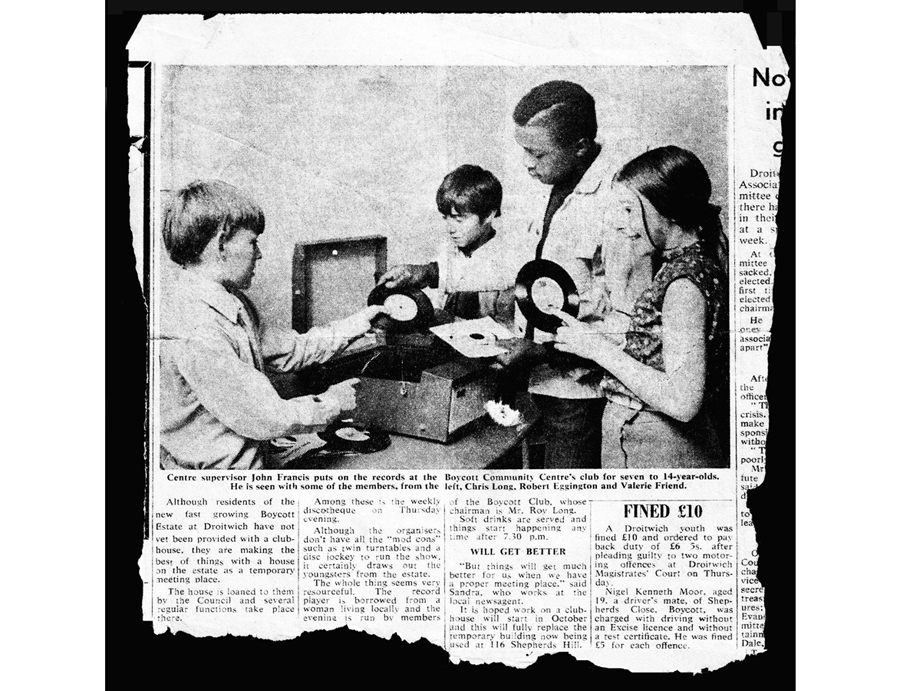 “I started playing punk & reggae in 78, then came the 2tone era which I was directly involved in. The second coming of the Mod’s got me deeper into soul & some northern, plus rhythm & blues, then later jazz funk & Latin jazz.
“I started playing punk & reggae in 78, then came the 2tone era which I was directly involved in. The second coming of the Mod’s got me deeper into soul & some northern, plus rhythm & blues, then later jazz funk & Latin jazz.
Whilst simultaneously I loved most of the new post-punk funk & electronic stuff. I would try to mix things up as much as possible- like dropping in A Certain Ratio or Liquid Liquid track in the Bali Hai in Brum’s Powerhouse & Nottingham’s rock city jazz room.
So basically whatever I liked & thought could work on dance floors. In that respect my direction has not changed – carried through from the 80’s to now.
I am mainly excited about old music to be honest, discovering amazing records I’d missed out on.
Artists seem to come & go very quickly these days. Of course over the years there have been many new artists I have become excited about – but not so much in the last 5 or 6 years. The last British artist I really was into was Zomby, from the States I always check new music from Moodymann. I’m a sucker for anything that has elements of dub or music with fierce authentic percussion, or some musical nuance or subtle fusion of elements I’ve not heard before.”
Which venues did you play in and around Birmingham back in the day, and what was the atmosphere like? Were the crowd appreciative and what music styles went down well?
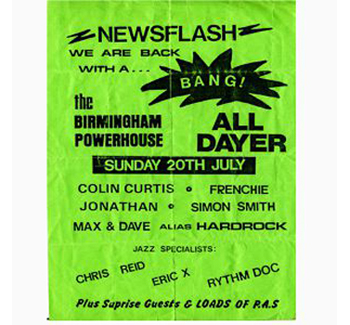 “The Powerhouse (Locarcno) Bali Hai room was my most regular gig. The atmosphere in that venue was something that will probably never be replicated.
“The Powerhouse (Locarcno) Bali Hai room was my most regular gig. The atmosphere in that venue was something that will probably never be replicated.
The reason being there were ‘tribes’ from most major cities & towns representing, with unique & idiosyncratic styles, in both dance & fashion.
The main room had an incredible sound system, which I heard was built by the same company that built Pink Floyd’s touring rig in the late 70’s. Super clear & heavyweight. I played in the smaller jazz room where the dancers would be the main focus, the interaction between them & the DJ was very special & personal.
It was a given that you would push them to their absolute limits – freak them out! From that room I got a reputation for championing samba/batucada infused music.
In the main room I saw some incredible live shows, including Prince Charles & the City beat Band, Lonnie Liston Smith & Cameo.
There were other memorable one-off places, The Hummingbird all-dayer with Paul Murphy, with it’s ‘Saturday Night Fever’ illuminated dance floor, Bobby Browns with Baz fe Jazz, Chris Reid & Eric X. Mostly tho I would be DJing at my own nights in Coventry.”
I understand you no longer live in the UK. What made you move, where are you now, and how does the music scene compare to the UK?
 “Actually that’s not correct, I live two weeks of each month in London & the other 2 weeks in Tallinn; Estonia & I have kept his schedule now for about the last 15 years.
“Actually that’s not correct, I live two weeks of each month in London & the other 2 weeks in Tallinn; Estonia & I have kept his schedule now for about the last 15 years.
In 1997 I went to DJ in Tallinn, met my wife & together with Raul Saaremets established a club night which has been going monthly now for almost 20 years. The population of Tallinn is about 400,000, which is approximately one third of the whole of Estonia, so it’s a small place.
The music scene is vibrant but not comparable to the UK in anyway. Some great groups & live acts who tend to come & go or change into another band, plus a handful of great DJ’s. The club scene & night life is quite limited due to the small captive audience being shared around, but there are some great spaces for different styles of events. Still everything is represented in Estonia, from cutting edge electronic to mainstream cheese – just in smaller & or less frequent packages.”
Please could you name your top ten club nights as a punter or DJ, anywhere in the world, and briefly explain why you chose them?
1. ‘Shoop Shoop‘ at the Golden Eagle, Hill St. approx 1976-79. DJ & promoter Mike Horseman (rip) had amazing vision to put this together. Huge custom built sound system, a fusion of funk, reggae & punk, with a crowd to match the diverse & cutting edge music.
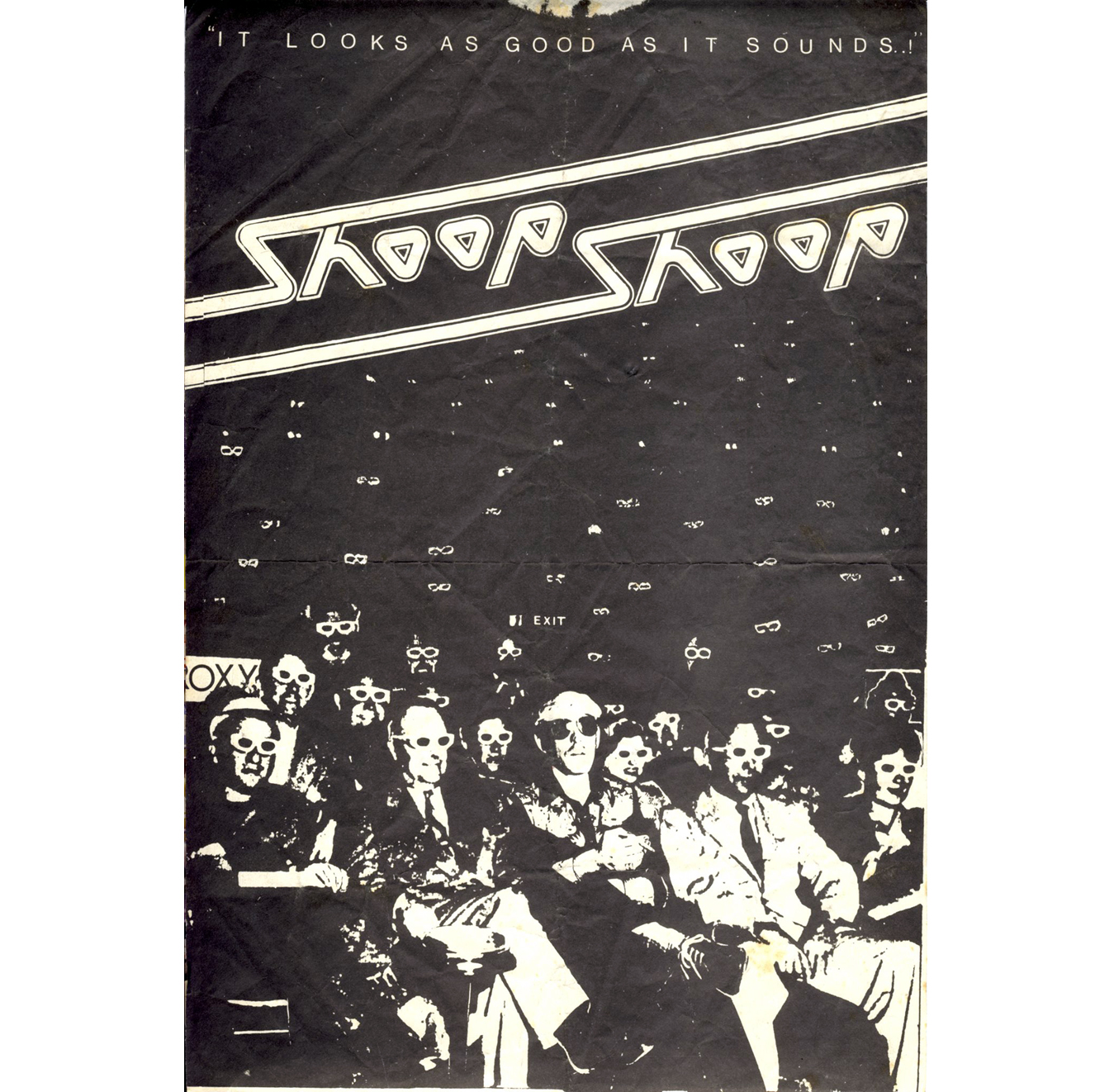 In the top room of a superb Art Deco pub, entered via a huge spiral staircase. A very compact room which turned into a sweat-box for 3 hours every Thursday from 7.30. Mike was the main man for me, the person from whom I got & still get inspiration to DJ.
In the top room of a superb Art Deco pub, entered via a huge spiral staircase. A very compact room which turned into a sweat-box for 3 hours every Thursday from 7.30. Mike was the main man for me, the person from whom I got & still get inspiration to DJ.
2. The Bali Hai jazz rooms, Birmingham Locarno, Hurst St approx 77-79. DJs Shaun Williams, Graham Warr & Dave Till. The first incarnation before I DJ’d there.
Just a beautiful place to hang out & occasionally shake a leg to the freshest & heaviest jazz funk. The room was done out like a mystical fictitious island, a tropical scenario, tribal faces with illuminated eyes, cave like structures dark & mysterious, not cheesy at all.
3. Romulus, Hagley Rd approx 1975. I only went there once, at the time of Bowie’s ‘Young Americans’ & Ferry’s Forties flirtations, & the crowd dressed to impress, I saw a fella there in gold lamé suit! De rigueur for men were peg trousers, short sleeve shirts, plastic sandles, the women in big skirts & low slung stiletto’s. As well as the above mentioned I heard plenty of funk, like War’s ‘Low Rider’ & James Brown’s ‘Sex Machine’.
4. Turia, Roppongi, Tokyo 1987. A massive hi-tech cavernous space with 6 turntables, amazing sound system & a lighting rig that moved up through the 3 floors.
I DJ’d there with Mike ‘Hitman’ Wilson. The club had an amazing restaurant, that you entered via a narrow cave like hole in the wall, down some twisty stairs covered in sand into a space with 2 Bedouin tents & deep sandy floor. The place was closed a year later after the lighting rig collapsed, killing three people.
5. Sound Factory Bar, NYC, 1992-3. I went several times to the Underground Network parties hosted by Barbara Tucker with Louie Vega behind the decks. I was on the guest list so had to check in with Willie Ninja. So from the start you just knew it was going to be high quality all the way.
As well as Louie & superb live acts in the main room, downstairs was a ‘disco’ room, where I heard, Kenny Carpenter & Hippie Torrales to name a couple. The dancers there were also amazing, the main dance floor occasionally turning in on itself b-boy battle style, tho they danced more like those from the UK jazz rooms.
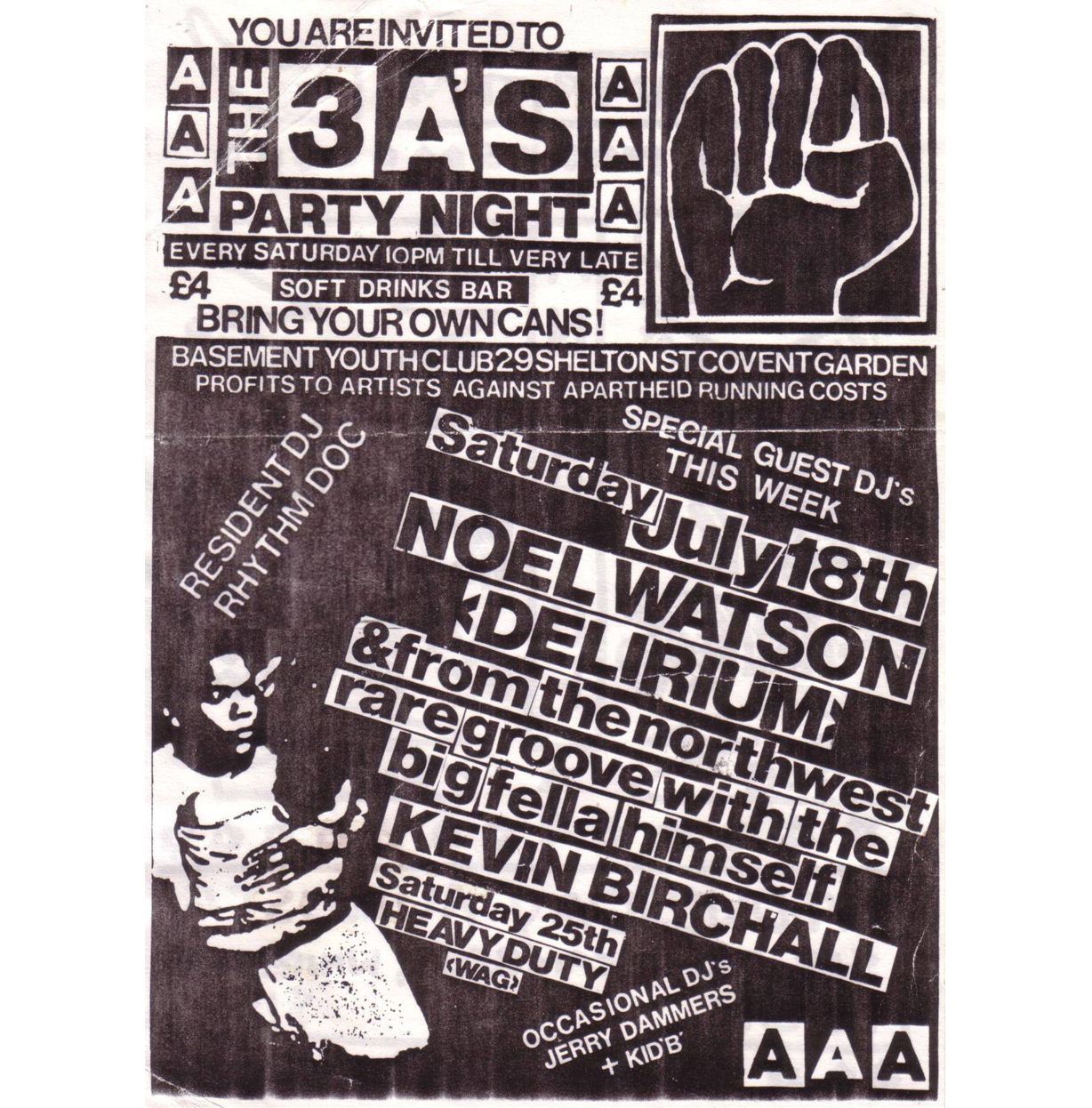 6. The 3A’s -Artists Against Aparthied, Shelton St, London 1987. I ran this night with Jerry Dammers, every Friday for about 7 months. It was the first place I played regularly after I’d moved down from the Midlands. Many of London’s finest DJ’s played there with us.
6. The 3A’s -Artists Against Aparthied, Shelton St, London 1987. I ran this night with Jerry Dammers, every Friday for about 7 months. It was the first place I played regularly after I’d moved down from the Midlands. Many of London’s finest DJ’s played there with us.
Soul II Soul, Derek B, Noel Watson; Tim Westwood, On U Sound System etc etc. It was a basement youth club with vaulted ceilings.
We put a massive rig in there which a company kindly rented us for free. At the time house music was rarely heard in central London, it was all rare groove, but we used to mix it up & Jerry insisted on a smoke machine & strobe, I disliked it at the time – I credit him for that catching on in later house clubs.
We used to run all night till the last person left. Sadly police intervention closed us down. The room is preserved for posterity tho, it features in an early scene in ‘Quadrophenia’, a club where there’s a young band playing. It’s now Belgo restaurant.
7. Jackie 60’s, New York, 1992-3. Again I only went once. I remember the place was in a really seedy area, the meat packing district. When we walked into the sweat-box, they were playing a record I produced for 8 Ball records ‘Enjoy Life’, which was amazing to hear.
On stage the host, Johnny Dynell was compering a strip show contest of people from the audience – with my record as the soundtrack! It was hilarious as he coerced the strippers to ‘Get it off!’ often he resorted to pulling the clothes off the contestants.
 The toilets were quite intimidating for me, everything you could imagine was going on in there, but after asserting myself & speaking out everyone was friendly, think it must have been my English accent.
The toilets were quite intimidating for me, everything you could imagine was going on in there, but after asserting myself & speaking out everyone was friendly, think it must have been my English accent.
8. M&M, Bodrum, Turkey 1996. I had a 2 week residency at this amazingly beautiful club, which was half indoors – half outdoors.
The space was overlooked by a medieval fortress & the outdoor space backed onto the sea, with a pier & moorings for the millionaire owners & their friends.
Some guests would literally arrive by luxury yacht. The music was run of the mill house fare but being able to large it up in this playboy setting was great fun. Jerry Dammers actually visited me there as he was on holiday on Kos & took a boat over.
9. La Palace, Paris, 1991. I had a record label called Mama & we made a showcase at this prestigious club. We took 4 musicians who had recorded for the label & we jammed to a largely gay crowd that included Jean Paul Gaultier, who came up to he booth to say hello. I was introduced there to an up & coming DJ who was playing in the back room called David Guetta.
 10. Patarei Vangla, Tallinn, Estonia, 2013. Unfortunately a space now out of bounds for parties. This huge sprawling fortress built by Tsar Nicholas the first was used for a few years to host a ‘rave festival’.
10. Patarei Vangla, Tallinn, Estonia, 2013. Unfortunately a space now out of bounds for parties. This huge sprawling fortress built by Tsar Nicholas the first was used for a few years to host a ‘rave festival’.
The promoters gave my event ‘Mutant Disco’ the pick of the place & we chose a walled outdoor space away from the main areas.
We transformed it into a magic garden, for about 400 people, add great sound, lights & smoke & we partied for 10 hours from dusk till past dawn (see image).
Do you still get back to the UK to DJ, if not, would you if the right offer came along?
“I’m in the UK every month & DJ once or twice each visit.”
The mix we have featured is a mixture of boogie, Afro house, reggae, jazz and funk, can you name your top five favourite tunes to get a disco moving?
“In a housey situation: Dennis Ferrer – Son of Raw, Martyn & Mike Slott – All Nights.
In a funky soul situation: Bob & Earl – The Harlem Shuffle, The Beginning Of The End – Funky Nassau.
In any other situation: Max Romeo & The Upsetters – Chase The Devil.”
What are you hot music event tips for 2017?
“Sorry no answer.”
Final question, digital v vinyl, which one for you and why?
“I use both, but prefer playing vinyl. I prefer going through a box of vinyl more than scrolling through a small screen on a cd player. It’s easier to remember your train of thought when seeing a record you have selected sticking out of the box ready for selection. You can’t do anything similar with digital unless pre-programmed which I would never do.
When the set up is correct for vinyl, I prefer the sound. I think digital sound, when listened to loud & for long periods fatigues the ears. I’ve never experienced that with on a quality vinyl set.
Digital only wins when the turntables are not correctly isolated from feedback or there is some other problem related to the cartridge or other connections. For that reason it’s good to have both formats.”
Thanks for your time Chris, and hope to catch you play London some time in the not too distant future.
Mix downloadable here for a short time.
Featured image courtesy of Martin Lazarev.
Interview by Nick Byng for Grapevine Birmingham.
